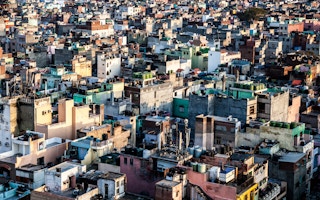Cities contribute two-thirds of India’s GDP, but also the bulk of India’s greenhouse gas (GHG) emissions. India’s urbanisation has been described as “messy” and “hidden” because much of it is unplanned and poorly regulated. Intensive resource use, waste, and pollution in cities exacerbate inequalities, diminish public health, and undermine productivity.
To continue reading, subscribe to Eco‑Business.
There's something for everyone. We offer a range of subscription plans.
- Access our stories and receive our Insights Weekly newsletter with the free EB Member plan.
- Unlock unlimited access to our content and archive with EB Circle.
- Publish your content with EB Premium.
To create health and liveable cities, India must make buildings, urban transport, and waste management more sustainable. This is also essential for India to achieve its nationally determined contributions (NDCs) by 2030 and net-zero target by 2070. One reliable solution lies in green public procurement in cities. Here I discuss the structural and systemic barriers that are holding back the greening of urban procurement, and some solutions.
The principles of sustainable/green public procurement (SPP/GPP) have been embedded in global climate discourse since the Rio ‘Earth Summit’ of 1992. The 10-year Marrakech Process on Sustainable Consumption and Production established by the UN Environment Programme in 2003 supported numerous countries in reforming their procurement systems to account for the ‘triple bottom line’ – combining economic development with social and environmental safeguards. In 2017, when UNEP compiled fact sheets on SPP progress in 40 countries, the sheet on India was conspicuously absent, whereas the United States and China, the only two countries with higher emissions than India, recorded their efforts and achievements.
India has hesitated to fully embrace the SPP paradigm despite having introduced the EcoMark labelling system as early as 1991, a year before Rio, enacting the Energy Conservation Act in 2001, and creating the National Action Plan for Climate Change in 2007 with provisions for procuring renewable energy. Likewise, while India has been an observer at the WTO Agreement on Government Procurement since 2010, it has no intention of joining, despite green trade barriers and green curbs on free trade agreements.
Greening of public procurement can make available a wider choice of sustainable products such as energy saving appliances and machinery, e-vehicles, products with more recycled content, sustainable building materials, water saving devices, and environmental management services. Government departments can be mandated to purchase such products and the aggregation of demand can ‘nudge’ manufacturers to reduce the carbon footprint of their products and seek green certification.
A federal polity
SDG 12.7 acknowledges that countries will promote SPP “in accordance with national policies and priorities”. An important reason for India’s reticence is the peculiarity of India’s federal structure. The Constitution of India mandates that climate should be handled by the national government while land management and city administration are the domains of state governments. The result is that although the national government maintains a Ministry of Housing & Urban Affairs as well as a Ministry of Environment, Forests and Climate Change, both are obliged to remain enlightened policy-makers but unable to control outcomes on ground.
A systems approach to administrating cities would recognise that as sites of demand generation and consumption, and the origin and end points of almost all value chains, cities are at the frontline of climate action. Nevertheless, due to their proclivity for retaining power, the national ministries create an unnatural schism between cities and climate action, isolating the urban transformation efforts in states’ domain from the climate transitions related to energy, industry, food production, transport, and lifestyles determined by national economic priorities.
In 2021, when the national urban affairs ministry revised the hitherto neglected National Mission on Sustainable Habitat, one of eight missions in the National Action Plan on Climate Change launched in 2008, it provided for “no separate financing”. The sustainable habitat mission’s goals, aligned with progress on the sustainable development goals (SDGs) and NDCs, would ostensibly be achieved through existing programmes such as the Smart Cities Mission. It was left to state governments and cities to raise finance and create the appropriate implementation ecosystems to achieve climate goals. The document made no mention of GPP.
The need for green procurement
At COP27 in 2022, India released a Long-Term Low-Emissions Development Strategy that includes an ‘urban strategy’ with ‘three pillars’: mainstreaming adaptation measures in urban planning, promoting climate-responsive and resilient buildings, and promoting low-carbon municipal service delivery. It is unclear how the strategy will be implemented, given the division of powers between the national and state governments, but the mainstreaming of GPP would greatly enhance the outcomes by clarifying the characteristics of sustainable cities.
Indian cities are denied the benefits of GPP because the national and state governments are slow to empower, train, and equip them for managing the paradigm shift. Cities pay the cost of inaction whereas early adoption of GPP would allow them to extract the maximum value from their spending.
The expenditure of the Ministry of Housing & Urban Affairs in 2022-23 is estimated at USD 9.5 billion. State governments usually contribute a matching amount. Funds from other ministries like roads, water, and health also flow into cities. The Finance Commission of India will transfer USD 2.8 billion to cities in 2022-23, as their share of the central tax pool. Thus, India’s cities may be procuring goods, works, and services worth close to USD 25 billion in just one year, though the amount reaching 4,041 cities, with populations ranging from 5,000 to over 20 million, may be quite small. This is an added reason for improving systems in smaller towns that must extract maximum value from every rupee spent.
Given that state governments’ share in total government expenditure is increasing, GPP adoption by a state can nudge its cities to follow. States can start with metropolitan cities, then work their way to towns and smaller settlements.
What it entails
Mainstreaming GPP in states and cities will require the standardisation, ease of implementation, and customisation that is best achieved using digital public infrastructure. Digital technology removes human intermediation, which is the bane of state delivery systems riven by corruption and inefficiency.
“
Greening of procurement is a prerequisite for greening of cities.
The Government e-Marketplace (GeM) launched in 2016 is a decisive shift towards GPP. It has over 600,000 registered businesses, including sellers of products and services related to renewable energy, energy-saving equipment, waste management, and electric vehicles. GeM is also promoting the circular economy by enabling the auction of obsolete and depreciated-value equipment and machinery, recyclable waste, scrap as well as land and buildings. A buyback function enables sellers to quote prices of new versions of products along with buyback prices of older ones. GeM is also offering ‘green transition services’ to help public organisations manage benchmarking, auditing, and planning for decarbonisation.
State governments can create their own e-marketplaces, just as they are promoting e-governance in municipalities. Although each city has unique needs due to size, geography, climate, and financial strength, it may not be desirable for all cities to create their own markets. State governments can leverage bulk procurement of green products to lower the ‘green premium’ attached to innovation, while also promoting, in exceptional cases, localisation of production to capture early-stage innovation. The Smart Cities Mission has launched an online City Innovation Exchange, where city administrations set out problems for vendors to solve with new products and technologies.
Trained procurement professionals are needed for mainstreaming GPP in states and cities, as well as extensive capacity building to produce standard bid documents and specifications, define performance standards, and for monitoring and evaluation. Performance criteria can become entry barriers if buyers are unable to distinguish between purveyors of ‘greenwash’ and genuine innovators. The market for green products must avoid the pitfalls of the market for pharmaceuticals, where lax regulation has ceded the market to expensive branded drugs, belying the promise of cheaper generics.
GPP systems also need protection from anti-competitive practices such as collusive bidding, cartelisation, and abuse of dominance that prevent cities from obtaining the best ‘value for money’ (VfM). The Government of India’s manuals for procurement of goods, works, and services emphasise VfM as an equally valid basis for public procurement as lowest cost, which tends to be the default mode.
VfM is best realised after considering life-cycle cost – the Smart Cities Mission mandated that cities budget for capital expenditure as well as operation and maintenance costs. An appreciation of VfM would breed quality consciousness, without which cities can neither mitigate emissions nor adapt to climate change. Greening of procurement is a prerequisite for greening of cities.
Jagan Shah is resident senior fellow, Artha Global


















